Latest News
South of the Border with Lenny, Felicia, and the New York Phil
Posted November 28, 2023
South of the Border with Lenny, Felicia, and the New York Phil
By Gabryel Smith
When the New York Philharmonic and the U.S. State Department first began discussions of a Latin American tour in 1955, little did either party know how the unforeseen forces of Leonard Bernstein and Felicia Montealegre would provide such fuel to this cultural and diplomatic mission.
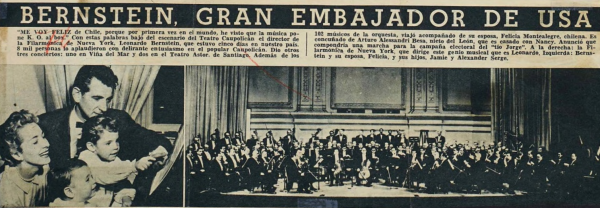
[Vea, Santiago, Chile, May 29, 1958]
In the midst of the McCarthy era, and after the death of Stalin in 1953, the U.S. Government experimented with various soft power approaches to counter a rise in Russian musicians, theater, and dance companies touring the world as USSR-sponsored cultural ambassadors. In 1954, President Eisenhower successfully lobbied the House Committee on Appropriations to earmark significant funding into an Emergency Fund for International Affairs that sponsored overseas cultural productions. The president wrote: “I consider it essential that we take immediate and vigorous action to demonstrate the superiority of the products and cultural values of our system of free enterprise.”*
The American National Theater and Academy (ANTA), a New York City institution founded by the New Deal-era Federal Theater Project, was tapped to distribute the funds. The New York Philharmonic, in the midst of organizing a tour to the Edinburgh Festival and Europe in 1955, benefitted quickly from a $50,000 subsidy that paid for charter jets to and from Europe. The funding was a boon: not only did it provide for the first jet travel undertaken by the orchestra, thereby saving weeks of per-diem expenses aboard a ship; it helped tip the scales of a labor dispute with the Musicians’ Union over travel and tour rehearsal times. The only ANTA requirements: a non-negotiable stop in Berlin and at least one American composition per program.
On the tails of the Philharmonic’s European success, the next project solidified imminently. The Philharmonic had caught on to an important detail: if they considered visiting some of the “unfriendlier” portions of the globe, much more money was available. Even before the orchestra embarked for Europe, Philharmonic management began sending feelers out to prominent South American music establishments on the possibility of a tour with Musical Director Dimitri Mitropoulos and frequent guest, audience darling (and possible successor) Guido Cantelli.
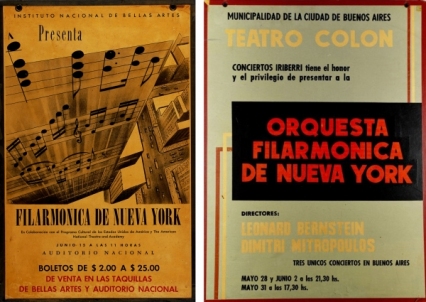
[Posters for concerts in Mexico City, Mexico, and Bogota, Columbia]
Cantelli’s tragic death in a plane crash in Paris in 1956 upended the Philharmonic’s 1956-57 season, and cemented Leonard Bernstein’s unrivaled place as Mitropoulos’ replacement. Both were styled co-conductor in 1957-58, and both would share the podium on the Latin American Tour. Major press attention for Bernstein -- including profiles in Life magazine and an appearance on the cover of Time in February, 1957 -- would only help the cause. The prospect of the Philharmonic’s first American-born conductor, who could also communicate in Spanish, traveling with his Chilean wife charmed the Latin American capitals well before the tour began.
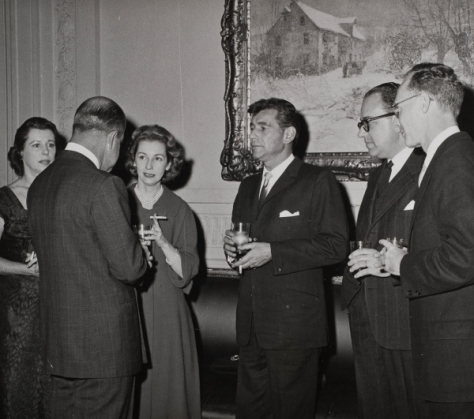
[Felicia Montealegre and Leonard Bernstein with Alberto Ginastera at a reception with the U.S. Ambassador Willard Beaulac in Buenos Aires, Argentina. May 28, 1958]
Immediately after its final concert in Carnegie Hall on Sunday, April 27, 1958, the New York Philharmonic departed for Panama, beginning the seven-week tour, the longest in its history. 39 concerts followed in rapid succession: Caracas, Maracaibo, Bogotá, Cali, Medellín, Quito, Guayaquil, Lima, La Paz, Asunción, Santiago, Valparaíso, Buenos Aires, Mendoza, Córdoba, Montevideo, São Paulo, Rio de Janeiro, Porto Alegre, and Mexico City. ANTA’s requirement of minimum one American work per program did not pose a problem for Lenny, who happily performed the third symphonies of Aaron Copland and Roy Harris, Gershwin’s American in Paris,and Chavez’s Sinfonía India. Mitropoulos did not join until the end of May in Buenos Aires, where he introduced excerpts from Barber’s Medea and Falla’s Three cornered hat, and Ginastera’s Creole Faust overture.
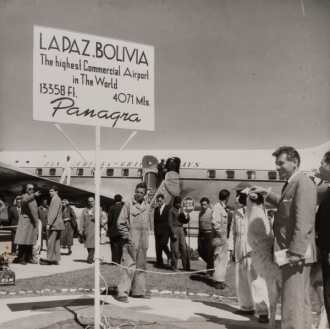
[Arrival at La Paz Airport, Bolivia. May 14, 1958]
With nearly three quarters of the performances falling to Bernstein, including the entire first month, the lion’s share of recognition went to him. Reports in the Spanish language press were not only impressed by the performances but by the conductor’s charisma, “chosen by Vogue as one of the 10 most attractive men of the moment (‘junto a Marlon Brando’)” and nicknamed the “Presley de la batuta” for his gestures while conducting [Ercilia, Santiago].
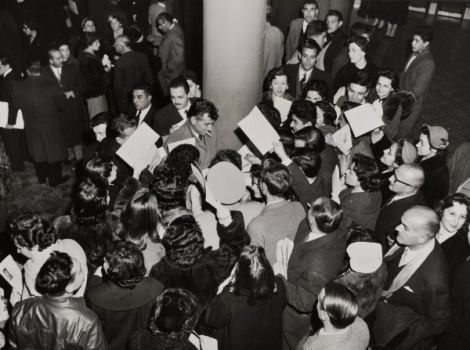
[Leonard Bernstein signing autographs in Cordoba, Argentina. May 29, 1958]
Writing from Buenos Aires on May 30, Philharmonic president David Keiser reported that “Our new conductor has really been a trump and I cannot say enough in his favor. He has not missed a single concert nor rehearsal, been ready on time on practically every occasion and given his best at every concert despite many poor halls, inadequate dressing facilities, quantities of unauthorized people in the wings and even on stage, pianos that were second class for the most part and often poorly tuned, unreliable transportation to and from theatres and many other incidents. He has had several bad colds, was affected by extreme heat in Guayaquil and altitude in the high places, but has come through on every occasion and proved a fine example to the men and I feel a great boon to the Society. Beyond the music he has attended press conference without number, luncheons, dinners, celebrations of local playing and dancing, good, bad, and indifferent and has charmed the old and fascinated the young… I do not believe a man of more years or less vitality could have carried out such a schedule – I say this because just to keep up with it all, without having to conduct has been a full time occupation, albeit a most wonderful one for Sylvia and me.”
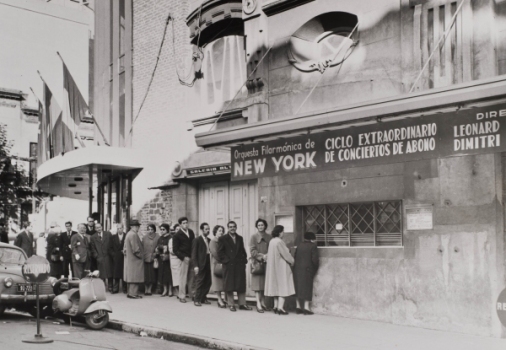
[Audience lines up at the Estudio Auditorio del Sodre in Montevideo, Uruguay. May 26, 1958]
The attention and praise fueled Bernstein’s energy. Three days in, writing to the yet-to-arrive Felicia, Bernstein reported, “we’re the all time smash… 7,000 middle classers in a perfect Concha Acoustica ate up Copland and Roy Harris [in Caracas]… I’m the local hero, I’m loaded with presents; tons of records of folk music, [and] a liki-liki, which is a great beige linen national garment, very handsome with a high collar held by gold links.”
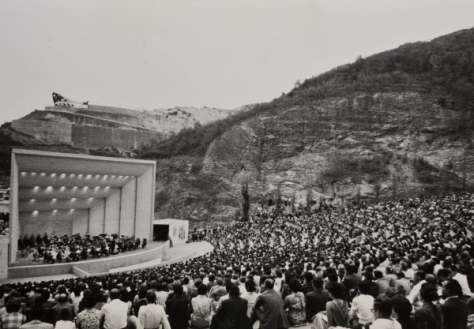
[A record crowd of 7,000 fills the Concha Acustica in the hills above Caracase, Venezuela, to hear the New York Philharmonic in a program of Haydn, Roy Harris, Gershwin, and Ravel conducted by Leonard Bernstein. May 1, 1958. Photo by Hamilton Wright.]
Comparing the Philharmonic’s trip to the simultaneous tour of the American Vice President, Bernstein noted that “we’re doing good—much more, according to all concerned, than Nifty Nixon, who has flubbed his whole mission in spades so far.” Indeed, Nixon’s motorcade was reportedly stoned by a Caracas mob, whereas Lenny and the Philharmonic were showered with flowers in that same city.
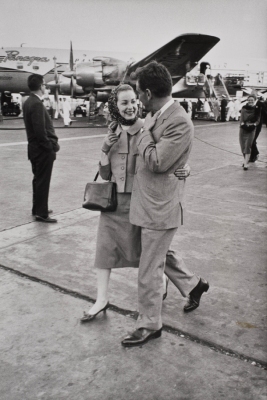
[Leonard Bernstein meets Felicia upon her arrival in Lima, Peru. May 13, 1958]
The secret weapon—Felicia—would arrive on May 13, not soon enough for the tour party and their hosts. (Lenny: “Again, of course, everyone knows you & loves you. They’ve all been expecting you & are sorely disappointed.”) When she did arrive, the press centered on her presence and charm, including mentions of the couple’s honeymoon in Mexico. Reporting to Newsweek, Felicia said “At the opening concert in Santiago, Chile, I thought how I had never imagined I’d hear my husband conduct the national anthem there, where I grew up. It was a beautiful, extraordinary moment and the tears were streaming down my face. It meant coming home in glory.”
![]()
[Leonard Bernstein with Felicia and her two sisters, Nancy Alessandri and Madeleine Armstrong backstage at Teatro Caupolican in Santiago Chile. May 22, 1958]
On their return, the Philharmonic was met by the NYC Department of Sanitation Band and a welcome home ceremony at City Hall hosted by Mayor Wagner, including the presentation of certificates of merit to the orchestra and medallions of the City of New York to Bernstein and Mitropoulos.
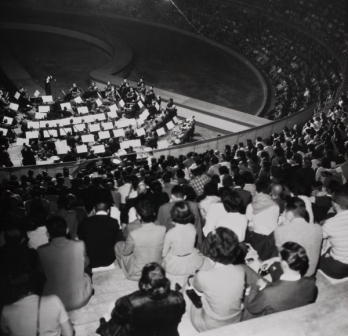
[Leonard Bernstein and the New York Philharmonic perform for a rapt audience of 18,000 at Maracanazinho Sports Arena in Rio de Janeiro, Brazil. June 11, 1958]
The response from the Special International Program for Cultural Presentations, which paid the entire $421,000 cost of the tour, can be summed up in a letter from President Eisenhower: “By sharing with our neighbors to the South the skills of one of the great orchestras of our country, we have drawn closer to the ideal of mutual understanding and friendship which is our goal. I am especially glad to know that the success of the orchestra’s mission, founded on the fine musicianship of each member of the orchestra and of the brilliance of the conductors, Dimitri Mitropoulos and Leonard Bernstein, was further enhanced by the personal friendliness and warmth of the conductors and musicians.”
The partnership with ANTA and the State Department would continue shortly thereafter, with the Philharmonic’s tour to the Soviet Union and the Near East the following year, including a historic televised concert of Bernstein and the Philharmonic in Moscow, taped and aired for American audiences on CBS. To a room full of rapt Muscovites, including Dimitri Shostakovich, Bernstein performed a program highlighting similarities in Russian and American music. “We two giant nations cannot afford to be unfriendly,” he said. The applause was deafening and prolonged.
Gabryel Smith is the Director of Archives and Exhibitions at the New York Philharmonic.
All photos courtesy of the New York Philharmonic Shelby White & Leon Levy Digital Archives.
*For more on the Emergency Fund for International Affairs consult Jonathan Rosenberg’s excellent Dangerous Melodies: Classical Music in American from the Great War through the Cold War.